The first personal computers: LPG-30, Bendix G-15
What about buying a personal computer worth several hundred thousand dollars, or even a million? Take a couple of tens of square meters in your apartment as a workplace and ... enjoy the "quiet" operation of the device. Not the best deal, is it?
The first computers were far from miniature sizes. These were the real facilities. Just imagine the scale: 42 blocks, of which the world's first electronic universal computer ENIAC (1946) consisted, occupied a room of almost 170 square meters. 30 ton monster, consuming about 160 kilowatts. In addition, they cost a lot of money. For example, the first conventionally commercial computer UNIVAC I (1947-1951), covering an area of about 36 square meters, would have cost you almost $ 1.5 million in 1956.

The invention of the transistor in 1948 and the integrated circuit in 1958 contributed to the gradual reduction in the size of machines. By the mid-50s, the creation of small, economical computers ceased to be a utopia. And consequently, the range of their application has expanded. Now even medium-sized organizations and enterprises could afford to purchase such a device. LGP-30 and Bendix G-15 were among the most sought-after and well-known small-sized computers.
USA 1956 The LGP-30 was born. At that time, this pleasure, the size of a refrigerator, was already worth 47 thousand dollars (now equivalent to 403 thousand dollars). Stanley Frankel, a talented young theoretical physicist - became the developer of the first personal computer. He was born in 1919 in Los Angeles, studied physics, and received his doctorate from the University of California at Berkeley. His first scientific article appeared in 1940, two years after he received a bachelor's degree.

Los Alamos National Laboratory. Start
Later he worked with nuclear scientist Robert Oppenheimer, who in 1943 went to work at the famous laboratory in Los Alamos, New Mexico, where he developed an atomic bomb. Frankel followed him. Los Alamos is a secret city, the construction of which began in 1942. Here it was planned to build the world's first atomic bombs.
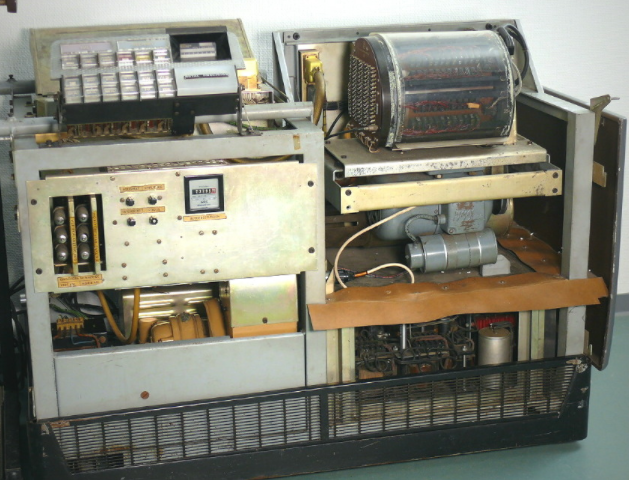
LGP-30 without a cover front view: top right - magnetic drum storage device

LGP-30 without rear view cover
The scientist took an active part in the project to create the American atomic bomb, known as Manhattan, but, due to allegations of anti-American activity, his path in the field of nuclear physics, alas, was cut short.
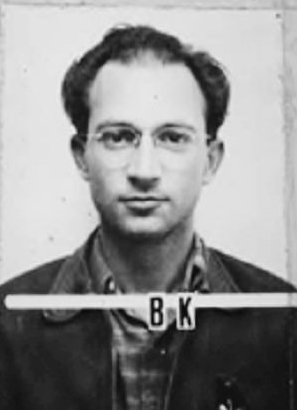
Stanley Frankel
After the war, Frankel was one of the first ENIAC programmers. Since 1949, Stanley got a job at the California Institute of Technology in Pasadena, where in 1954 he created a simple electronic computer MINAC.
Stanley, becoming an independent consultant in the field of computing, created a computer that, compared to the “crumb» ENIAC, seemed like a little one. Reducing the size to the size of a desk - 1.12 x 0.66 x 0.84 meters and 365 kilograms without peripherals - was achieved by replacing the electron tubes with semiconductor diodes and memory placement on a magnetic drum.
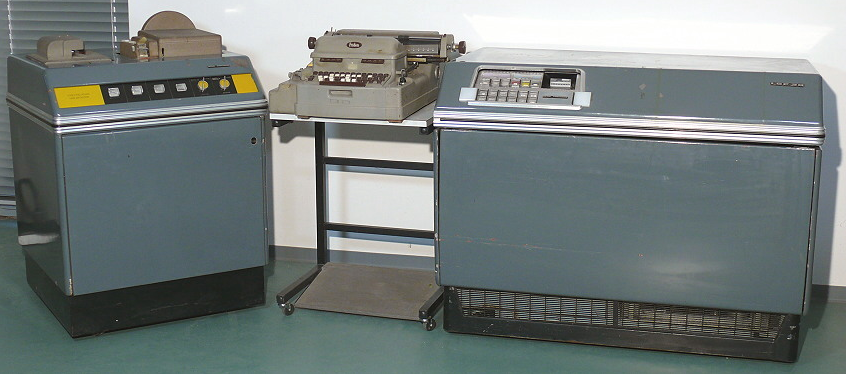
The device consisted of 113 lamp cells and 1,350 germanium diodes. To him was a writing machine of the company Friden, a device for reading from punched tapes, a tape punch.

LGP-30 diode array
The rotation speed of the magnetic drum LGP-30 - 3600 revolutions per minute, the amount of memory - 4096 32 bit words, the main clock frequency was 137 kHz.

Magnetic Drum LGP-30
LGP-30 was mainly installed in laboratories for relatively simple scientific calculations, such a device was intended for one operator. Consumed LGP-30 1.5 kW and powered through a regular room outlet, and for cooling no longer needed a special air conditioning system. For the eight-hour shift, there was one operator and part-time programmer.

LGP-30 processor
Until 1958, 40 of these computers, according to the license agreement, were issued by Schoppe & Faeser in Germany.
In addition to the LGP-30, Frenkel later developed several more computers, and in 1964, one of the first electronic desktop calculators Cogito 240SR.

Cogito 240SR
He was so carried away with the game with computers that, according to the recollections of his colleagues, did not pay attention to anything else.
Stanley Frankel died in May 1978 in Los Angeles. Its LGP-30 was a pioneer in a series of electronic computing mini-machines that have been developed since the 1960s.
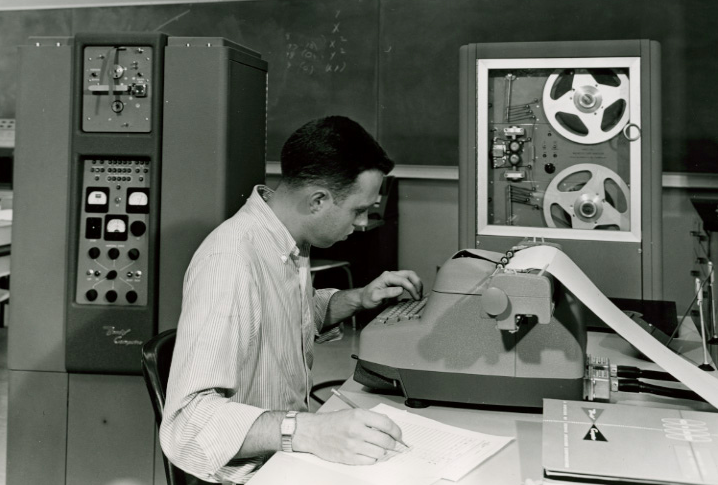
BENDIX G-15
Another well-known computer of less impressive size, called personal - Bendix G-15 was created in 1954-1956. Its developer is an outstanding American scientist, computer genius - Harry Husky.

Harry husky
Bendix Corporation was not originally a computer company, but after seeing the prospects, it occupied its niche in this area of business. To create their first computer, they hired a person with experience who had already “filled his hand” by taking part in the creation of other computers, Harry D. Husky.
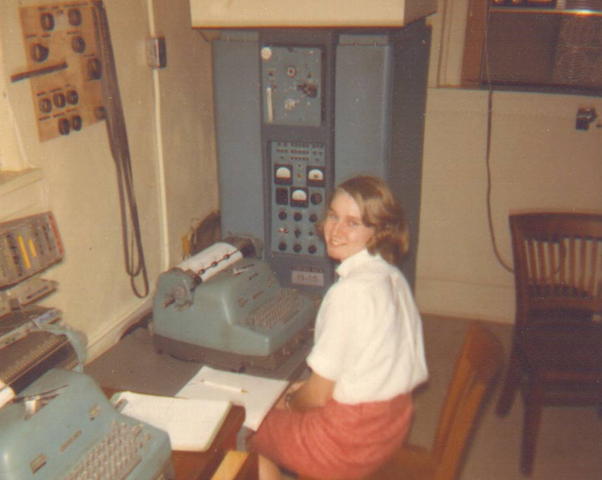
Working at the University of Pennsylvania, in 1943, Husky took part in the creation of ENIAC and was responsible for developing the output and printing system. After World War II, he lived for three years in England and worked on the creation of the first English computers. Later, returning home, under his leadership, saw the light of the computer SWAC - in 1950 was the fastest computer in the world.

SWAC
In 1956, the Bendix G-15 became a commercial computer; at that time, the device could be purchased for 60 thousand dollars or, more attractively, to rent it for fifteen thousand dollars a month.
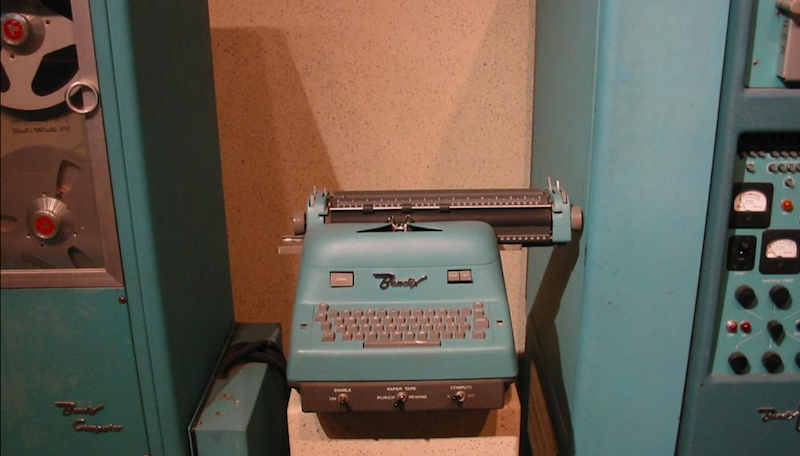
It was a relatively small computer weighing 450 kilograms with dimensions of 1.5 x 0.9 x 0.9 meters. The power consumption was 3 kW. The element base consisted of 180 lamp cells, 300 germanium diode cells. The device's memory is on a magnetic drum. The amount of memory was 7.6 KB, the word length - 29 bits. The G-15 computer worked with a clock frequency of 105 kHz.
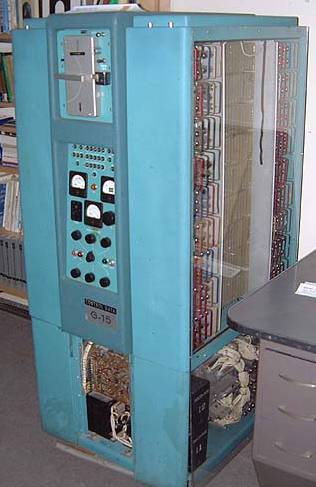
Peripheral input and output devices with punched tapes and punched cards, plotter, memory on magnetic tapes were connected to Bendix G-15. The Intercom 1000 interpreter and the Algo compiler were a simple alternative to machine programming language.
As it was written in the brochure to Bendix G-15, even an inexperienced user can use the device for solving problems, having completed a training course that was only 4 hours. The operator to work with the machine needed to know only simple operating commands. The list of commands contained all arithmetic operations.

Bendix G-15
In fact, the G-15 was a surprisingly small computer, perhaps the smallest commercially available electronic digital computer of its time. It was usually described as “fridge-sized”, with a basic system consisting of an IBM I / O electric typewriter cabinet.

Low cost and ease of electronic computing with the G-15, already serving dozens of progressive enterprises, large and small, all over the world.
In the end, about 400 pieces of G-15 were produced and sold. Significantly less than the IBM 650, but enough to make a computer one of the most common in the early 1960s.

IBM 610. PAC "Personal Automatic Computer"
Among competitors computers LPG-30 and Bendix G-15, you can surely distinguish the IBM 610. Because of its name PAC "Personal Automatic Computer" in the literature most often refer to it as the first first personal computer. It was developed by engineer John Lentz (employee of IBM Corporation) in 1948.

Engineer John Lenz
The car was presented on September 3, 1957, as a tool created to solve problems arising in modern science, technology and business. It costs a lot to pay 55 thousand dollars for the IBM 610, as it was inferior in performance to its contemporaries. It was possible to issue a rental for $ 1,150 per month. A total of 180 copies were released.
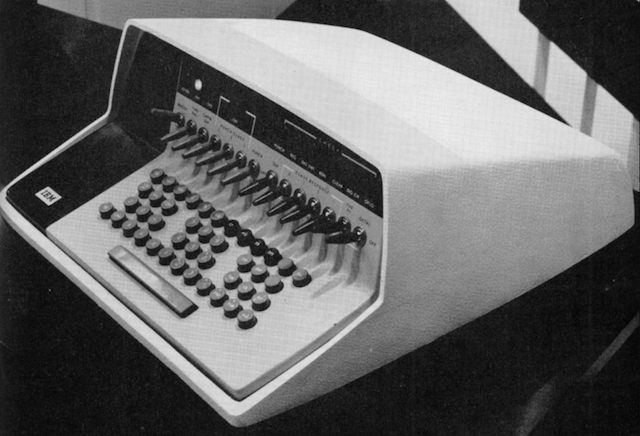
The IBM 610 was designed to work at the console of one operator, in a small office or enterprise. Data was entered using punched tape and keyboard, an electric typewriter was used for output. The memory device is a magnetic drum. It was possible to power the IBM 610 from a household outlet. The machine was affordable, reliable, it was one of the first computers that was programmed from the keyboard.

For more than half a century of rapid development of the world of technology and, accordingly, devices, it is difficult to imagine the scale and scope of the personal assistant of that time. Gradually, year after year, the size of computers decreased more rapidly, productivity increased, hundreds of different machines were developed and created, famous players entered the world market, some companies disappeared. In a word - progress. It does not cost anything to bring a laptop weighing not 1 ton, but just a kilogram with a performance that in the 50 years of the last century we were even afraid to imagine. Mobility, accessibility, high performance - the main criteria which scientists and developers of the first personal computers wanted so much to achieve - are no longer a utopia.
Come on. Not enough to make a home computer? You have a choice - to rent a dedicated server in one of the data centers. Numerous server configurations, affordable prices, high reliability - freedom of choice in everything.
As advertising. Stock! Only now get up to 4 months of free use of VPS (KVM) with dedicated drives in the Netherlands and the USA (configurations from VPS (KVM) - E5-2650v4 (6 Cores) / 10GB DDR4 / 240GB SSD or 4TB HDD / 1Gbps 10TB - $ 29 / month and above, options with RAID1 and RAID10 are available) , a full-fledged analogue of dedicated servers, when ordering for a period of 1-12 months, the conditions of the promotion are here, existing subscribers can receive a 2-month bonus!
How to build the infrastructure of the building. class c using servers Dell R730xd E5-2650 v4 worth 9000 euros for a penny?
The first computers were far from miniature sizes. These were the real facilities. Just imagine the scale: 42 blocks, of which the world's first electronic universal computer ENIAC (1946) consisted, occupied a room of almost 170 square meters. 30 ton monster, consuming about 160 kilowatts. In addition, they cost a lot of money. For example, the first conventionally commercial computer UNIVAC I (1947-1951), covering an area of about 36 square meters, would have cost you almost $ 1.5 million in 1956.

The invention of the transistor in 1948 and the integrated circuit in 1958 contributed to the gradual reduction in the size of machines. By the mid-50s, the creation of small, economical computers ceased to be a utopia. And consequently, the range of their application has expanded. Now even medium-sized organizations and enterprises could afford to purchase such a device. LGP-30 and Bendix G-15 were among the most sought-after and well-known small-sized computers.
The first personal computer LGP-30
USA 1956 The LGP-30 was born. At that time, this pleasure, the size of a refrigerator, was already worth 47 thousand dollars (now equivalent to 403 thousand dollars). Stanley Frankel, a talented young theoretical physicist - became the developer of the first personal computer. He was born in 1919 in Los Angeles, studied physics, and received his doctorate from the University of California at Berkeley. His first scientific article appeared in 1940, two years after he received a bachelor's degree.

Los Alamos National Laboratory. Start
Later he worked with nuclear scientist Robert Oppenheimer, who in 1943 went to work at the famous laboratory in Los Alamos, New Mexico, where he developed an atomic bomb. Frankel followed him. Los Alamos is a secret city, the construction of which began in 1942. Here it was planned to build the world's first atomic bombs.

LGP-30 without a cover front view: top right - magnetic drum storage device

LGP-30 without rear view cover
The scientist took an active part in the project to create the American atomic bomb, known as Manhattan, but, due to allegations of anti-American activity, his path in the field of nuclear physics, alas, was cut short.

Stanley Frankel
After the war, Frankel was one of the first ENIAC programmers. Since 1949, Stanley got a job at the California Institute of Technology in Pasadena, where in 1954 he created a simple electronic computer MINAC.
Stanley, becoming an independent consultant in the field of computing, created a computer that, compared to the “crumb» ENIAC, seemed like a little one. Reducing the size to the size of a desk - 1.12 x 0.66 x 0.84 meters and 365 kilograms without peripherals - was achieved by replacing the electron tubes with semiconductor diodes and memory placement on a magnetic drum.

The device consisted of 113 lamp cells and 1,350 germanium diodes. To him was a writing machine of the company Friden, a device for reading from punched tapes, a tape punch.

LGP-30 diode array
The rotation speed of the magnetic drum LGP-30 - 3600 revolutions per minute, the amount of memory - 4096 32 bit words, the main clock frequency was 137 kHz.

Magnetic Drum LGP-30
LGP-30 was mainly installed in laboratories for relatively simple scientific calculations, such a device was intended for one operator. Consumed LGP-30 1.5 kW and powered through a regular room outlet, and for cooling no longer needed a special air conditioning system. For the eight-hour shift, there was one operator and part-time programmer.

LGP-30 processor
Until 1958, 40 of these computers, according to the license agreement, were issued by Schoppe & Faeser in Germany.
In addition to the LGP-30, Frenkel later developed several more computers, and in 1964, one of the first electronic desktop calculators Cogito 240SR.

Cogito 240SR
He was so carried away with the game with computers that, according to the recollections of his colleagues, did not pay attention to anything else.
As for Mr. Frenkel, he became infected with a disease ... a very serious disease that is a great nuisance to work. The disadvantage of computers is that you can play with them. They have so many different buttons, switches ... Frenkel had nothing to do with anything, he stopped leading anyone. The work went very, very slowly, and he sat in the engine room, trying to figure out how to make a single tabulator automatically calculate and print the arctangent X.
Stanley Frankel died in May 1978 in Los Angeles. Its LGP-30 was a pioneer in a series of electronic computing mini-machines that have been developed since the 1960s.
Bendix G-15

BENDIX G-15
Another well-known computer of less impressive size, called personal - Bendix G-15 was created in 1954-1956. Its developer is an outstanding American scientist, computer genius - Harry Husky.

Harry husky
Bendix Corporation was not originally a computer company, but after seeing the prospects, it occupied its niche in this area of business. To create their first computer, they hired a person with experience who had already “filled his hand” by taking part in the creation of other computers, Harry D. Husky.

Working at the University of Pennsylvania, in 1943, Husky took part in the creation of ENIAC and was responsible for developing the output and printing system. After World War II, he lived for three years in England and worked on the creation of the first English computers. Later, returning home, under his leadership, saw the light of the computer SWAC - in 1950 was the fastest computer in the world.

SWAC
In 1956, the Bendix G-15 became a commercial computer; at that time, the device could be purchased for 60 thousand dollars or, more attractively, to rent it for fifteen thousand dollars a month.

It was a relatively small computer weighing 450 kilograms with dimensions of 1.5 x 0.9 x 0.9 meters. The power consumption was 3 kW. The element base consisted of 180 lamp cells, 300 germanium diode cells. The device's memory is on a magnetic drum. The amount of memory was 7.6 KB, the word length - 29 bits. The G-15 computer worked with a clock frequency of 105 kHz.

Peripheral input and output devices with punched tapes and punched cards, plotter, memory on magnetic tapes were connected to Bendix G-15. The Intercom 1000 interpreter and the Algo compiler were a simple alternative to machine programming language.
As it was written in the brochure to Bendix G-15, even an inexperienced user can use the device for solving problems, having completed a training course that was only 4 hours. The operator to work with the machine needed to know only simple operating commands. The list of commands contained all arithmetic operations.

Bendix G-15
In fact, the G-15 was a surprisingly small computer, perhaps the smallest commercially available electronic digital computer of its time. It was usually described as “fridge-sized”, with a basic system consisting of an IBM I / O electric typewriter cabinet.

Low cost and ease of electronic computing with the G-15, already serving dozens of progressive enterprises, large and small, all over the world.
In the end, about 400 pieces of G-15 were produced and sold. Significantly less than the IBM 650, but enough to make a computer one of the most common in the early 1960s.
IBM 610

IBM 610. PAC "Personal Automatic Computer"
Among competitors computers LPG-30 and Bendix G-15, you can surely distinguish the IBM 610. Because of its name PAC "Personal Automatic Computer" in the literature most often refer to it as the first first personal computer. It was developed by engineer John Lentz (employee of IBM Corporation) in 1948.

Engineer John Lenz
The car was presented on September 3, 1957, as a tool created to solve problems arising in modern science, technology and business. It costs a lot to pay 55 thousand dollars for the IBM 610, as it was inferior in performance to its contemporaries. It was possible to issue a rental for $ 1,150 per month. A total of 180 copies were released.

The IBM 610 was designed to work at the console of one operator, in a small office or enterprise. Data was entered using punched tape and keyboard, an electric typewriter was used for output. The memory device is a magnetic drum. It was possible to power the IBM 610 from a household outlet. The machine was affordable, reliable, it was one of the first computers that was programmed from the keyboard.

For more than half a century of rapid development of the world of technology and, accordingly, devices, it is difficult to imagine the scale and scope of the personal assistant of that time. Gradually, year after year, the size of computers decreased more rapidly, productivity increased, hundreds of different machines were developed and created, famous players entered the world market, some companies disappeared. In a word - progress. It does not cost anything to bring a laptop weighing not 1 ton, but just a kilogram with a performance that in the 50 years of the last century we were even afraid to imagine. Mobility, accessibility, high performance - the main criteria which scientists and developers of the first personal computers wanted so much to achieve - are no longer a utopia.
Come on. Not enough to make a home computer? You have a choice - to rent a dedicated server in one of the data centers. Numerous server configurations, affordable prices, high reliability - freedom of choice in everything.
As advertising. Stock! Only now get up to 4 months of free use of VPS (KVM) with dedicated drives in the Netherlands and the USA (configurations from VPS (KVM) - E5-2650v4 (6 Cores) / 10GB DDR4 / 240GB SSD or 4TB HDD / 1Gbps 10TB - $ 29 / month and above, options with RAID1 and RAID10 are available) , a full-fledged analogue of dedicated servers, when ordering for a period of 1-12 months, the conditions of the promotion are here, existing subscribers can receive a 2-month bonus!
How to build the infrastructure of the building. class c using servers Dell R730xd E5-2650 v4 worth 9000 euros for a penny?
All Articles